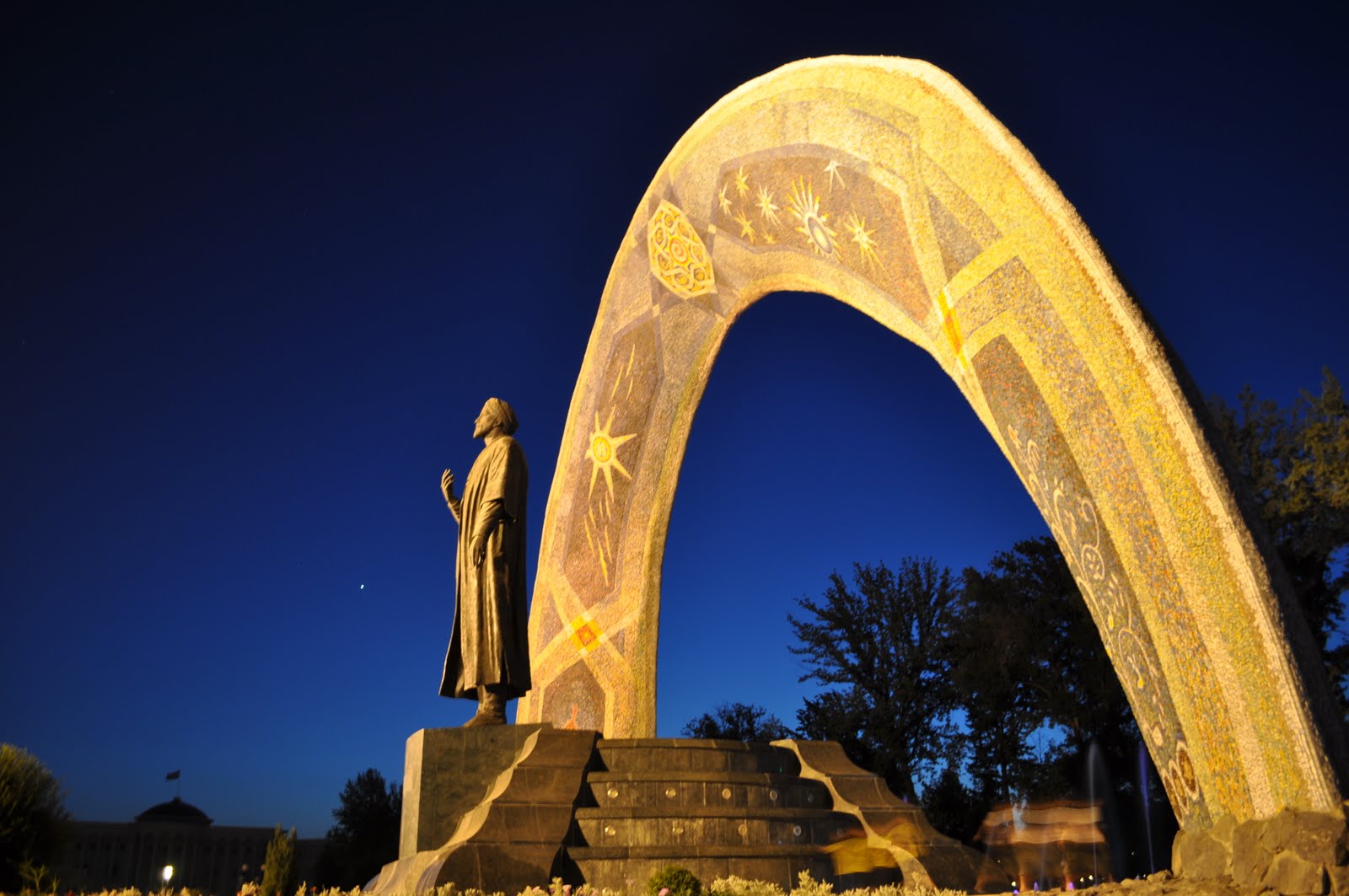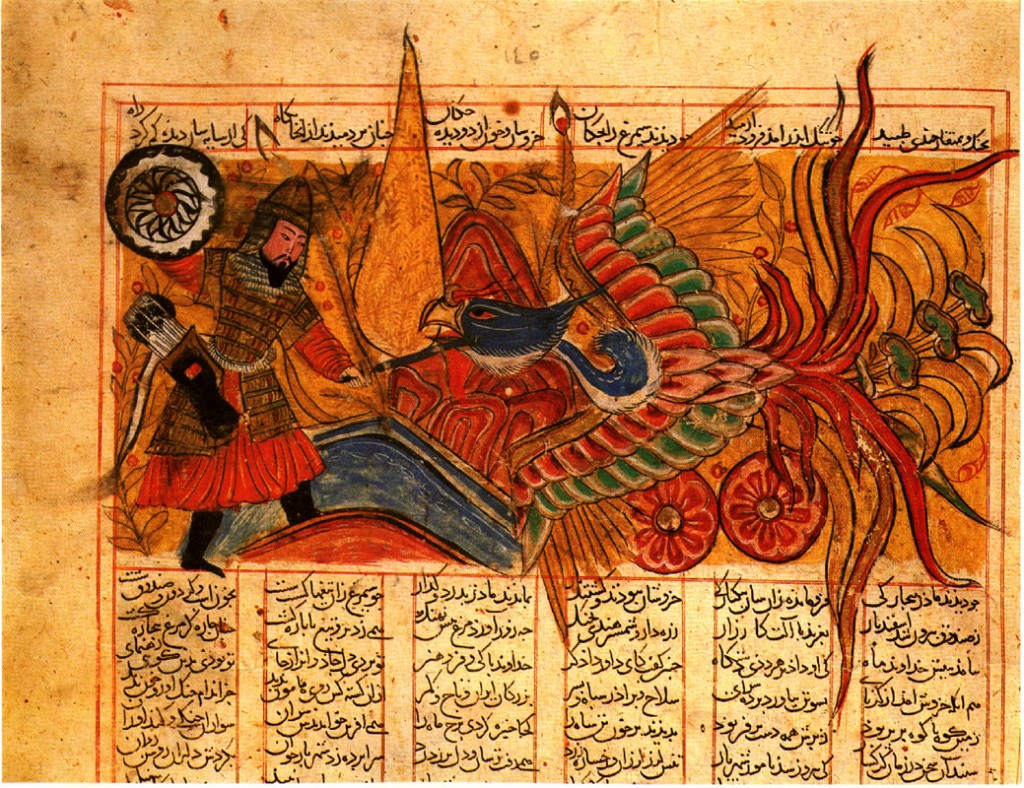Originally published by Ajam Media Collective on January 17, 2013.
A tribute to Ajam Media Collective’s name and inspiration, this post was written by Ajam’s editors, Alex Shams, Rustin Zarkar, and Beeta Baghoolizadeh. Photographs by Preethi Nallu originally published in Al Akhbar English, republished with author permission.

Epic literature occupies a key role in formulating and maintaining cohesive national and cultural identities– elucidating the spirit and values of a society as well as exploring mythic and historical origins. Works of epic literature are often retroactively embedded with political meaning, particularly after the rise of ethnic nationalisms in the 19th and 20th centuries. For modernizing nationalists, epics served a key role as tools to both create and strengthen ethnic and linguistic unity by highlighting (and almost always, distorting) a shared national history.

The Shahnameh (Book of Kings), completed by Hakim Abul-Qasim Ferdowsi in 1010 CE, is the undisputable national epic poem of the pan-Persian-speaking world. Composed of nearly 50,000 couplets, its narrative covers Creation to the Islamic conquest of Greater Iran (Iran Zamin) in the 7th century. Accentuating this chronicle are the tales of kings and heroes— from legendary champions like Rostam to historical personalities such as Alexander the Great. Cherished by communities in Iran, Afghanistan, Tajikistan, the Caucasus, and their respective diasporas, the Shahnameh links these societies to an imagined shared cultural past.
Due to his inclusion of pre-Islamic Iranian mythology, Ferdowsi is often accurately categorized as a pioneer of linguistic and cultural preservation for the Persian-speaking world. However, many rulers of Central Asia and the Iranian Plateau have politicized the Shahnameh by promoting it as a quintessential text that delineates “Persian-ness”— standing as a testament to the perseverance of Persianate culture in the face of Arab and Turkic domination. While there is no doubt that the Shahnameh has helped conserve the rich cultural heritage of the Iranian peoples, nation-states have historically propagated several misconceptions about the Shahnameh unrelated to its content and artistic form. These myths have attained the status of legend among many of the Shahnameh‘s most avid fans, despite their falsehood.
These myths include, but are not limited to:
- The Shahnameh is devoid of any Arabic vocabulary and is the first textual example of a resurgent Persian language.
- Iran’s cultural encounters with the Arab World and Turkic peoples have been confrontational and highly detrimental to the supposed ‘cultural purity’ of the Iranian peoples.
- The Shahnameh is essentially a secular text and indirectly or directly opposes Islam, Islamicate societies, and/or Arabs.
With this overview, we do not intend to lessen the significance of the Shahnameh for the Persian-speaking world. By focusing on Iran and its 20th century national enterprise, we hope to place Ferdowsi and the Shahnameh in their historical contexts, analyzing them as an examples of cross-cultural exchange—not ethno-linguistic exclusion.
Empire, Language, and Literature
When Arab armies swept across the Iranian plateau in the 7th century, the Persian Empirecrumbled under the weight of its political and social burdens, swiftly succumbing to the Arab conquerors. Over the course of 200-300 years, the majority of Iranians gradually converted from Zoroastrianism to Islam. The Arab conquest connected previously fragmented regions, and as a result, Arabic emerged as the lingua franca, allowing for greater cultural exchange as armies, thoughts, and ideas moved across the caliphate.
Often, modern scholars position Ferdowsi as the savior of Persian, suggesting that the Arab conquests silenced Persian-speakers until Ferdowsi wrote his magnum opus. This claim, however, dismisses the rich history of Persian poetry prior to the Shahnameh. Abu Abdullah Jafar ibn Muhammad Rudaki of Panjrud, in present-day Tajikistan, for example, lived about a century earlier than Ferdowsi and is credited with writing the first Persian poems in the new script adopted from Arabic.

Additionally, Ferdowsi did not invent the “book of kings” genre and often borrowed from his contemporaries. Abu-Mansur Daqiqi, also from Tus, wrote an earlier shahnameh. Ferdowsi acknowledges and praises Daqiqi in his exordium and used his couplets extensively, including around one thousand lines on Zoroaster. What is special about Ferdowsi’s, then, is not that it retrieved Persian from a linguistic vacuum, but rather that it was a seminal work of Persian, one of the largest of its time.
Structure and Content of the Shahnameh

Several tales of the Shahnameh— such as the tyranny of the Arab King Zahhak, and the long conflict between Iran and Turan— are often misread through a selectively nationalist lens, positioning Iran in opposition to the outside world. This reading places a moral and existential dichotomy between Iranians and non-Iranians. Closer examination, however, reveals that Ahriman was the source of corruption within the Shahnameh, and the frontiers beyond the Iranian plateau were often sought out by the Iranian protagonists, including Siyavash and Sohrab. Beyond glorifying the Iranian people, Ferdowsi also introduces nefarious Iranian characters as well, namely Sudabeh and the incompetent King Kay Kavus.
Nationalist language purists revere the Shahnameh for its strict reliance on Persian vocabulary. Many 20th century scholars, like Orientalist E.G. Browne, argued that Ferdowsi practiced linguistic protectionism— deliberately avoiding the use of Arabic. It contains 706 words of Arabic origin occurring 8,938 times— approximately 9% of the total vocabulary, compared to 30% in 10th century Persian literature. The introduction and conclusion, however, have much higher proportions of Arabic. Based on the variable proportions of Arabic in segments of the Shahnameh, Mohammad Djafar Moinfar argued that subject material and style affected the percentage of loan words, not an inherent aversion to the Arabic language.
In addition to the use of Arabic, the Shahnameh uses many literary tropes also common in Arabic and Turkish court poetry. As a heroic epic dedicated to a king, it contains an exordium that praises divine and temporal authority, revealing both the author’s faith as well as his familiarity with the panegyric tradition. The exordium exalts God, Sultan Mahmud of Ghazni, the Prophet (using the Persian payghambar, as well as the Arabic nabi) and his family (ahl-e bayt). The secular nationalist interpretation of the Shahnameh dismisses these components of the text and speculates that Ferdowsi merely followed a literary formula. By doing so, this interpretation obscures these religious markers for the sake of contemporary political argument. Regardless, the structure of the Shahnameh consists of both Zoroastrian and Islamic attributes, enriched through linguistic diffusion and diverse literary forms.
Visual Tradition
As the Shahnameh’s literary structure and content reflects synergy rather than antagonism towards multiculturalism, so too does its visual components. Soon after its completion, the Shahnameh was repeatedly commissioned for royal courts in Southwest and Central Asia, supplemented by dozens of detailed illustrations in the Persian miniature style. These images adopted visual motifs and themes originating well beyond the boundaries of Greater Iran, a testament to aesthetic cosmopolitanism.

Following the devastating Mongol Invasions in the 13th century, trade networks were re-established, easing communication and commerce throughout Eurasia. East Asian arts were also diffused along these commercial routes, inspiring Ilkhanid and Timurid-era artists in Tabriz, Herat, and Shiraz. Their illustrations combined traditional Persian painting with appropriated Chinese methods and techniques, as reflected in landscapes, facial features, and clothing.
Furthermore, representations of celebrated Iranian mythological creatures— like the Simorgh— were greatly influenced by Chinese depictions of the dragon and the phoenix (fenghuang). Though these illustrations were produced several centuries after Ferdowsi, they have become indelible components to both the Shahnameh and Iranian visual culture. The importance of miniature design and court commissions lasted dynasty after dynasty until the Qajars, as evidenced by Fat’h ‘Ali Shah’s Shahanshahnameh (Book of the King of Kings) from the early 19th century.
State Nationalism and Ferdowsi in Public Space
The 20th century Iranian modernization project linked the Shahnameh to a secular nationalism that hailed purity and homogeneity over multiculturalism. With the adoption of Persian nationalism as state doctrine after 1925, Ferdowsi’s Shahnameh emerged as a prime target for politicization. The Shahnameh suited the Pahlavi dynasty’s goals in two key ways. First, by linking ancient pre-Islamic Persia and today, the Pahlavis sought to distinguish themselves from the Semitic Arab World by underlining Iran’s uninterrupted “Aryan” linguistic and, thus, racial credentials. Second, by portraying Ferdowsi as an anti-Arab figure, the Pahlavis created an icon of secular Persian nationalism that opposed Islam’s “corrupting” influence, justifying the contemporary political projects of forcible secularization. The new pseudo-academic Shahnamehscholarship taught Iranians that Ferdowsi symbolized opposition to Arab influence and helped spread the three major myths outlined above in Iranian schools.

As this ideology was integrated into every aspect of public life, Ferdowsi streets and squares blossomed across the nation. Eager to provide a suitable “Persian nationalist” tomb for their “Persian nationalist” hero, nationalists did not spare Ferdowsi’s tomb in the northeastern Iranian city of Tus. In the 1920’s the Society for National Heritage (Anjoman-e Asar-e Melli) emerged with the aim of preserving Iran’s cultural patrimony, building and rebuilding dozens of mausoleums and national monuments, shaping them to represent contemporary political beliefs regarding Iran’s past. As scholar Talinn Grigor has outlined in detail, the Society applied Pahlavi ideology to the public sphere, erasing the complexity of Iranian cultural and architectural history.

The 1934 reconstruction of Ferdowsi’s Tus mausoleum was central to this effort, involving the destruction of the existing monument in order to erect one that suited Persian modernist taste and highlighted a chauvinist view of history that erased influences deemed insufficiently “Persian.” The monument contains a farahavar, a Zoroastrian symbol, copied directly from Persepolis. Besides the monument’s influences from ancient Persian design, the white stone signifies the Persian “purity” of the Shahnameh with respect to its non-inclusion of Arabic words. It’s name, “Ferdowsiyeh,” taken from the Shia Hosseiniyeh, implies that the tomb should become a site of contemporary pilgrimage just as Iranians had historically visited the tombs of Shia religious figures (imamzadeh).
Ferdowsi’s tomb at Tus embodied his centrality to the Pahlavi ideological project, its reconstruction removing the beautiful cultural fusion and complexity of centuries of mixing that his work represented. Instead, it propagated a reductionist version of Iranian history that prided itself on cultural purity and ignored the diversity of contributions not only to the Shahnameh but also to Iranian culture at large.

Towards a Multicultural Perspective
The purpose of this post is not to diminish the importance of Ferdowsi and Shahnameh for Iranian national heritage. It is vital, however, that we not take 20th century notions of ethnic separatism and apply them to 10th-11th century works. Ferdowsi’s work speaks to the cultural invigoration of the Iranian Peoples and the lands of Ajam, a revival summarized in the following couplet popularly attributed to Ferdowsi to note his monumental achievement:**
بسى رنج بردم در اين سال سى
عجم زنده كردم بدين پارسى
I struggled greatly during these thirty years,
I gave life to the Ajam with this Persian.
It is crucial to recognize the centrality of the Shahnameh to Iranian or Persianate transnational culture and heritage not because it combats Islam or foreign dominance, but exactly because it engages with and combines varied cultural influences. Ajam did not come alive because Ferdowsi denied our past and the diverse Persian, Arabic, and Turkic roots that helped formulate notions of Iranian, Afghan, and Tajik nationhood; Ajam came alive because Ferdowsi recognized that cross-cultural pollination enriches us all.
**Editor’s note: The couplet mentioned in the article was not composed by Ferdowsi, but has been attributed to the text centuries after its completion.